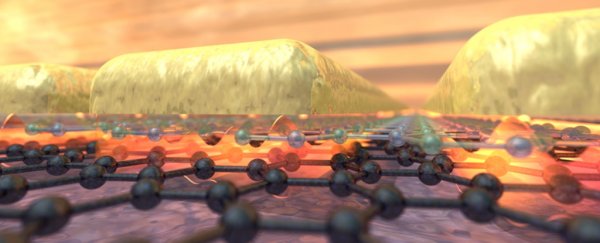With the help of the increasingly useful material graphene, scientists have managed to confine light into the smallest space possible - the size of a single atom.
If light can be locked up so tightly, it opens up all kinds of possibilities for electronics, sensors, and imaging devices in the future, potentially leading to computer chips and laser sensors far smaller than anything we're using today.
Practical uses are still some way off but the researchers are hugely excited by their discovery, realised through an experiment they describe as atom-scale Lego.
"Graphene keeps surprising us: nobody thought that confining light to the one-atom limit would be possible," says lead researcher Frank Koppens, from The Institute of Photonic Sciences (ICFO) in Spain.
"It will open a completely new set of applications, such as optical communications and sensing at a scale below one nanometre."
Ordinarily, light cannot be focussed on a spot smaller than its own wavelength, a barrier known as the diffraction limit.
Scientists have already been trying to break through this limit using nanoscale metal cages to guide photons of light, but so far the restrictions have led to too much energy loss.
Not so in this case. The researchers used stacks of 2D materials called heterostructures to build up a new nano-optical device, adding a graphene monolayer to act as a semi-metal because of the way it can guide light in the form of plasmons.
These plasmons are oscillations of electrons that interact strongly with light, and can therefore be used to guide it. On top of the graphene the team stacked a hexagonal boron nitride (hBN) monolayer as an insulator, and then an array of metallic rods.
Like many great scientific discoveries before it, this one was made by accident. "At first we were looking for a new way to excite graphene plasmons," says one of the team, David Alcaraz Iranzo from ICFO.
"On the way, we found that the confinement was stronger than before and the additional losses minimal. So we decided to go to the one atom limit with surprising results."
When infrared light was sent through the researchers' device, plasmons collected between the metal and the graphene. The team kept shrinking this space until it was just one atom thick – and found the plasmons were still vibrating and could still propagate freely.
The spread of plasmons could be controlled by switching an electric voltage on or off, demonstrating how light can be manipulated in a channel less than a nanometre thick.
For this to make a difference in optical switches, sensors, and detectors, everything else in a device will need to be shrunk down too, but this study shows that light can be contained in the smallest of channels.
Work is already well under way to develop light-based transistors – the small electrical units that drive today's gadgets – and this new development opens up the possibility of significant size reductions and speed improvements.
Further down the line, manufacturers should be able to pack more transistors into the same space (improving performance) or put the same number of transistors into a smaller space (reducing size), or a mix of both.
Whether you want a super-fast laptop for your next train journey or a computer in your ear, you might have graphene to thank when these devices start appearing.
"Having reached the ultimate limit of light confinement could lead to new devices with unprecedented small dimensions," says Andrea C. Ferrari of the Graphene Flagship research initiative, who wasn't directly involved in the research.
The research has been published in Science.
